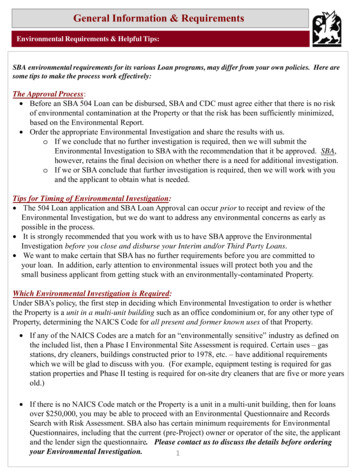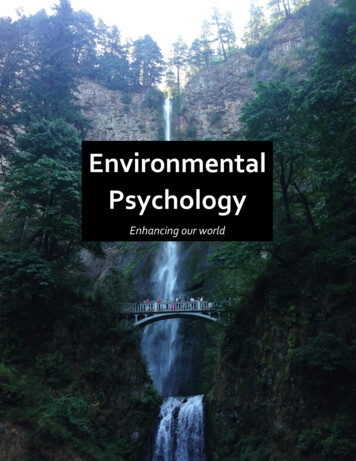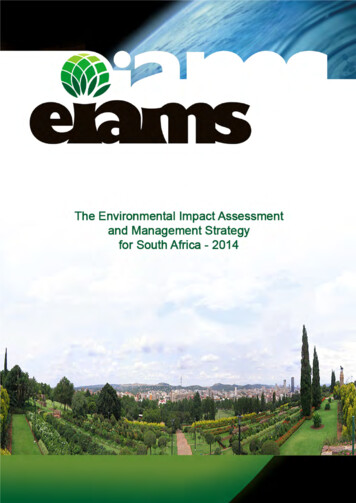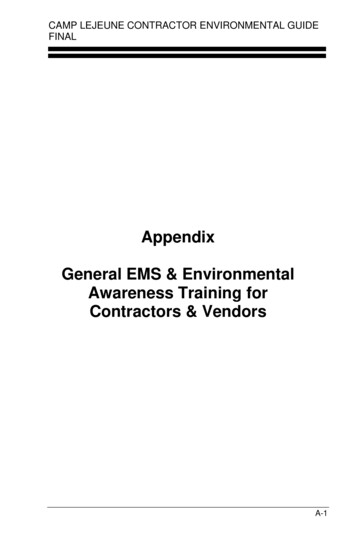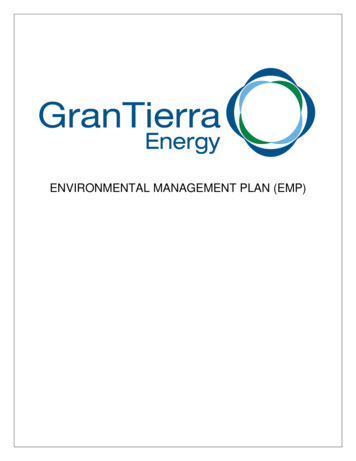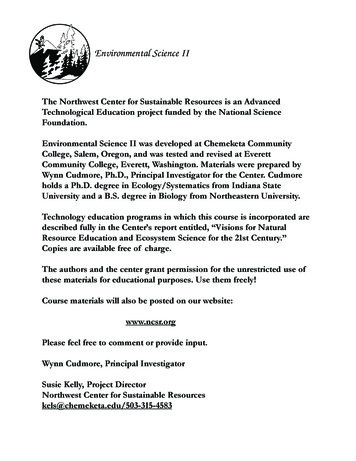
Transcription
ProceedingsThe Environmental Impact of ‘Superfoods’: A Space for Debateand Joint Reflection †Ana Fernández-Ríos 1,*, Jara Laso 1, Israel Ruiz-Salmón 1, Daniel Hoehn 1, Cristina Campos 1, Jorge Cristóbal 1,María Margallo 1 and Rubén Aldaco 1University of Cantabria. Department of Chemical and Biomolecular Engineering. Avda. los Castros s/n,39005, Santander, Spain. ana.fdezrios@unican.es (A.F-R); jara.laso@unican.es (J.L); israel.ruizsalmon@unican.es (I.R-S); daniel.hoehn@unican.es (D.H); cristina.campos@unican.es (C.C); jorge.cristobal@unican.es(J.C); maria.margallo@unican.es (M.M); ruben.aldaco@unican.es (R.A)* Correspondence: ana.fdezrios@unican.es† Presented at the 2nd International Electronic Conference on Foods, 15–30 October 2021; Available online:https://foods2021.sciforum.net/.1Abstract: This paper aims to provide an overview of the environmental impacts of superfoods. Forthis purpose, a bibliographic search was conducted to find articles developing the life cycle assessment of four of the most popular superfoods (quinoa, chia, spirulina, and kale), as well as identifypotential future environmental challenges. The main outcomes reveal that, with the limited information currently available, it cannot justifiably be claimed that superfoods present environmentalbenefits compared to traditional products, and the impacts will increase in a medium to long termdue to the change of current agricultural systems into intensive commercially oriented systemscaused by the growth of demand.Citation: Fern, A.; Laso, J.; RuizSalm, I.; Hoehn, D.; Campos, C.;Keywords: Life cycle assessment (LCA); GHG emissions; agri-food system; food choice; food supply chain (FSC); agricultural products; environmental challengesCrist, J.; María Margallo; RubénAldac The Environmental Impact of‘Superfoods’: A Space for Debateand Joint Reflection.2021, 68, x.https://doi.org/10.3390/xxxxxPublished: 15 October 2021Publisher’s Note: MDPI staysneutral with regard to jurisdictionalclaims in published maps andinstitutional affiliations.Copyright: 2021 by the authors.Submitted for possible open accesspublication under the terms andconditions of the Creative CommonsAttribution (CC BY) /).1. IntroductionIn recent years, the so-called ‘superfoods’ have become the influential new trend thathas taken over the food industry. Even though there is not an official definition of thisterm, superfoods are known as foods that provide an important amount of vitamins, minerals, protein, fiber, and other nutrients that play an important role in diets and contributeto the proper operation of the body [1]. According to the Superfoods Market Report 2020 [2],a growing demand trend on the consumption of superfoods was observed in last years,especially during the COVID-19 outbreak due to the concern of some citizens about maintaining a healthy diet and boosting the immune system. In addition, the global superfoodmarket is projected to increase a compound annual growth rate of 5.1% during the nextlustrum [2]. However, despite they can present an opportunity to address food insecurity[3], it is important to not underestimated other target problems, such as combating environmental degradation. Agriculture is a significant contributor to climate change, accounting for one-fifth of total greenhouse gas (GHG) emissions among all economic activities [4]. In fact, the overall food supply chain (FSC) has ecological interactions, not onlyby means of emissions, but also alongside land use, natural resources depletion or biodiversity loss [5]. For this reason, tools such as life cycle assessment (LCA) are key to supportthe transition toward increasing sustainability of current patterns of food production andconsumption [6]. In this context, the objective of the present paper is twofold. On the onehand, a revision of the state of the question regarding LCA applied to superfoods will beconducted, with the final goal of identifying the ‘gaps’ addressing this issue and proposing an appropriate methodology. On the other hand, a review of future environmentalProceedings 2021, 68, x. proceedings
Proceedings 2021, 68, x FOR PEER REVIEW2 of 6consequences of superfoods production, both in short and medium-long term, will be carried out.2. MethodsAccording to the objective, a bibliographic search was conducted to assess the stateof art of superfoods LCA-related studies and review their potential impacts in nature. Ina preliminary revision, it was observed that the number of articles is quite limited, so thatwe proposed four specific superfoods in order to obtain a global and general perspectiveof the state of the question. Hence, quinoa, chia, spirulina, and kale were considered sincethey are gaining the most attention from consumers today. The search was carried outusing the database of Scopus [7], as it has greater number of references and provides largerreliability than other widely used sources, such as Web of Science or Google Scholar [8].The terms “life cycle assessment” or “LCA” combined with “chia”, “kale”, “spirulina” or“quinoa” must appear in the abstract, keywords, or title. The methodology followed aswell as the results obtained in the search are illustrated in Figure 1. On the other hand, forassessing the environmental performance of these products in short and medium-longterm, the words “environment” and “superfood” were introduced in the database. In thiscase, Google Scholar [9] was included along with Scopus with the aim of maximize theamount of information and conclusions.Figure 1. Methodology and results of the bibliographic search conducted in Scopus.3. Results and Discussion3.1. Literature Revision and LCA Methodology Applied to SuperfoodsA total of 23 documents were found, but only seven were included in the review.Three of these articles addressed the LCA of the production of quinoa, whereas the remaining assessed spirulina. On the contrary, neither kale nor chia were evaluated from anenvironmental perspective using LCA as operational tool. In the case of spirulina, it isremarkable that most of the documents were excluded since they were focused on nonfood purposes, for instance, production of biodiesel or energy by means of algae biomass.Regarding the characteristics of the systems, we identified and assessed the key elements of LCA methodology: functional unit (FU), scope, impact assessment categories, aswell as other aspects such as software and database used. Generally, FU of 1 kg or ton ofproduct were largely considered, i.e., 1 kg [10] or 1 ton [11] of quinoa, or 1 kg of spirulina,both fresh or dried biomass [12,13] and tablets [14]. They present the simplest unit of reference for comparisons and is usually the most suitable for cradle-to-gate analysis, bothfarm gate [10,11], or processing-plant gate [12–14]. On the contrary, Cancino-Espinoza et
Proceedings 2021, 68, x FOR PEER REVIEW3 of 6al. [15] used a reference given by the weight of a direct-sale product, 500 g of packagedquinoa. This provides a very good reference unit in the case of eco-labeling of the product,since the consumer can know the environmental impacts of the package purchased andconsumed. Equally appropriate, although perhaps a bit more confusing, is the case of theFU of 'serving', used by Thomas et al. [16], since it developed the LCA of products containing spirulina, such as milk or jam, and therefore provided the impacts per consumption, not per quantity. In other cases, FU were used in reference to by-products or compounds extracted from the superfood itself, such as pigments [12], proteins [13,14], PUFA(polyunsaturated fatty acids) [12] or oil [13]. In relation to the software, four of seven studies conducted the assessment in SimaPro [11,13,15,16], whereas the remaining used R [10]or did it manually [12]. However, all authors applied the Ecoinvent database for calculations since it is one of the most consistent, coherent and transparent LCA databases [17].Finally, the environmental impact method and categories assessed varied significantly ineach study. The calculation of global warming potential (GWP) was common in all studies, probably due to the great importance of GHG emissions nowadays, and the importance of this indicator since it is one of the most used, representative, and understandable by almost everyone. Other indicators such as ozone depletion potential (OPD), resources depletion (ADP fossil and ADP elements), acidification (AP), eutrophication (EP),or toxicity indicators (HTP, MAETP, FAETP ) played an important role in these types ofstudies. However, the only recommendation when choosing impact indicators is that thechoice should depend on the type of product under study and the possible impacts it mayhave on the environment.3.2. Short and Medium-Long Term Challenges of SuperfoodsThe limited number of articles developing LCA of superfoods or their environmentaleffects hindering the process of drawing conclusions about the environmental benefits ofsuperfoods. At this point, there is not enough objective and quantitative evidence thatthese products offer a better environmental performance than other traditional foods. Forinstance, GHG emissions of the production of organic quinoa accounts 0.88 kg CO 2 eq./kg[15], whereas those of conventional quinoa 1.02 kg CO 2 eq./kg [10], and spirulina tablets7.7 kg CO2 eq./kg [14]. As comparative framework, conventional rice production generates1.65 kg CO2 eq./kg, organic rice an average of 2.7 kg CO2 eq./kg [18], beans 0.51 kg CO2eq./kg, corn 0.53 kg CO2 eq./kg, and pork 5.85 kg CO2 eq./kg [19]. In light of these values,no general conclusion can be reported, and only through the development of LCA of eachspecific food, accurate and well-justified arguments can be claimed. Fortunately, a growing trend in the publication of these articles is taking place, so that in a short to mediumterm these ‘gaps’ in knowledge can be filled.On the other hand, given that superfoods are mostly agriculture products, some environmental challenges can be identified according to the problematic of this sector. Likewise, based on the progress of the production and consumption patterns of other foodproducts, we can make some projections of the challenges we will have to face in a medium to long term. A summary of this information is illustrated in Figure 2.Even though the consumption of superfoods is not extremely high today, urbanization, high disposable income, and changing lifestyles of individuals is boosting their attention in the global market [20]. Currently, the main environmental side-effects associated with their production may lie in the hotspots of any agricultural activity, i.e., use ofagrochemicals and organic waste generation. It is believed that superfoods are producedin a ‘natural’ way, with little or no technological intervention and with traditional agricultural practices without chemicals [21]. Nonetheless, the reality differs considerablyfrom the theory. According to the inventory data of the LCA studies previously reviewed,quinoa production requires diesel and energy for transport and agricultural machinery,as well as organic (manure) or chemical fertilizers and pesticides for the organic [15] andconventional [11] production, respectively. Likewise, spirulina tablets production needs asupply of synthetic fertilizers and energy for the algae growth [14]. Although no other
Proceedings 2021, 68, x FOR PEER REVIEW4 of 6studies are available, it is logical to think that to produce other superfoods such as chia orkale, these types of products would also be necessary. On the other hand, food loss, whichoccurs in the production, harvesting and processing, could represent another importantissue, decreasing the yield and generating high amounts of waste to manage [22]. Anothercommon problem in food supply chains (FSC), and particularly in superfoods FSC, is thatthe production is located far from the consumption. Superfoods are usually produced in‘exotic’ locations, for instance, maca and quinoa are originated from Peru and açai fromthe Brazilian Amazon [21]. This makes products must travel significant distances to supply markets around the world, boosting transformations in processing technologies andpackaging, and impacting strongly on the environment. In addition, superfoods originatein most cases within complex and diverse crop agricultural systems. The increase in demand will force these systems to change into intensive and commercially-oriented production systems, causing profound impacts on landscape, diets, carbon footprints, andbiodiversity among others [23]. Agriculture intensification is usually accompanied bycommercialization and conversion to monocrop agriculture [24], so that sustainable intensification and agroecological practices present an opportunity to deal with this situation[25]. Crop diversification and additional diversification measures, such as crop rotation,mixed cropping, or changing cropping patterns, have the potential to lead to higher andmore stable yields, increase profitability, and achieve greater resilience in the agroecosystems in the long term [26]. On the other hand, policy measures are essential to influencedecisions of farmers and production methods, by means of, for instance, agri-environmental programs (AEP). AEP are a main possibility to encourage less intensive production,both to reduce market surpluses and to alleviate environmental pressure considering different action fields, e.g., environmentally friendly production methods [27]. In addition,the existence of third-party sustainability certifications represents a great opportunity toensure that all products consumed have a sustainable origin that has been tracked [23].Finally, at this point it is imperative to highlight the importance of addressing a life cyclethinking for ensuring a transition towards a more sustainable production and consumption patterns. Main challenges addressing LCA studies reside in the inherent variabilityof the agricultural system both in the inventory data and in the possible impacts, evidencing the need for specific guidelines for agricultural inventories [28].Figure 2. Summary of the environmental challenges and potential solutions addressing the superfoods sector.4. Conclusions
Proceedings 2021, 68, x FOR PEER REVIEW5 of 6The evident growth in the demand of superfoods along with the significant environmental impacts of the food sector have led to major concerning about the environmentalrepercussions of production and consumption patterns of these products. The bibliographic search reveals that, albeit an increase in the number of articles addressing LCA ofsuperfoods is producing, the amount of information is still too limited to draw objectiveand well-justified conclusions about the environmental benefits of these products. Currently, this market sector is quite small compared to the major commodities, but the challenges it faces now are the same as for the rest of agricultural activities, and they will growas demand increases. The shift from current agricultural systems to intensive commercialoriented systems will lead to a significant increase in emissions, loss of biodiversity, andother environmental issues. To deal with this trouble, sustainable intensification, agroecological practices, crop diversification and crop rotation, and, especially, a life cyclethinking, are key and provide the opportunity to achieve a sustainable and resilient superfood sector.Author Contributions: Conceptualization, R.A and M.M.; methodology, A.F-R, J.L., I.R-S, C.C.,J.C, and D.H.; investigation, A.F-R, R.A., and M.M; writing—original draft preparation: A.F-R.;writing—review and editing, , J.L., I.R-S, C.C., J.C, and D.H.; supervision, R.A. and M.M.; projectadministration, R.A.; funding acquisition, R.A. All authors have read and agreed to the publishedversion of the manuscript.Funding: This research was funded by the Spanish Ministry of Science and Innovation, grantnumber KAIROS-BIOCIR Project PID2019-104925RB (AEO/FEDER, UE).Acknowledgments: This study has been conducted thanks to the financial support of the ProjectKairos-Biocir: Enhancing the nexus water-energy-food to improve the agri-food sector in Spain(PID2019-104925RB) (AEO/FEDER, UE), financed by the Ministry of Science and Innovation of theGovernment of Spain. Ana Fernández thanks the Ministry of Science and Innovation of the Spanish Government with the State Program for the Promotion of Talent and Employability in R&D&Ifor the financial support via the research fellowship RE2020-094029.Conflicts of Interest: The authors declare no conflict of ESAN Information note on superfoods Available online: sionid l!1306075272?reqCode retrieve&bean.id 3465 (accessed onAug 27, 2021).Mordor Intelligence Superfoods Market - Growth, trends, COVID-19 impact, and forecasts (2021-2026); 2021;Massawe, F.; Mayes, S.; Cheng, A. Crop Diversity: An Unexploited Treasure Trove for Food Security. Trends Plant Sci. 2016, 21,365–368, doi:10.1016/j.tplants.2016.02.006.Tubiello, F.N.; Rosenzweig, C.; Conchedda, G.; Karl, K.; Gütschow, J.; Xueyao, P.; Obli-Laryea, G.; Wanner, N.; Qiu, S.Y.; Barros,J. De; et al. Greenhouse gas emissions from food systems: Building the evidence base. Environ. Res. Lett. 2021, 16, 065007,doi:10.1088/1748-9326/ac018e.Krishnan, R.; Agarwal, R.; Bajada, C.; Arshinder, K. Redesigning a food supply chain for environmental sustainability – Ananalysis of resource use and recovery. J. Clean. Prod. 2020, 242, 118374, doi:10.1016/j.jclepro.2019.118374.Sala, S.; Anton, A.; McLaren, S.J.; Notarnicola, B.; Saouter, E.; Sonesson, U. In quest of reducing the environmental impacts offood production and consumption. J. Clean. Prod. 2017, 140, 387–398, doi:10.1016/j.jclepro.2016.09.054.ELSEVIER Scopus Available online: www.scopus.com (accessed on Sep 10, 2021).Falagas, M.E.; Pitsouni, E.I.; Malietzis, G.A.; Pappas, G. Comparison of PubMed, Scopus, Web of Science, and Google Scholar:strengths and weaknesses. FASEB J. 2008, 22, 338–342, doi:10.1096/fj.07-9492lsf.Google Google Scholar Available online: www.scholar.google.es (accessed on Sep 10, 2021).Gamboa, C.; Bojacá, C.R.; Schrevens, E.; Maertens, M. Sustainability of smallholder quinoa production in the Peruvian Andes.J. Clean. Prod. 2020, 264, doi:10.1016/j.jclepro.2020.121657.Lotfalian Dehkordi, A.; Forootan, M. Estimation of energy flow and environmental impacts of quinoa cultivation through lifecycle assessment methodology. Environ. Sci. Pollut. Res. 2020, 27, 21836–21846, doi:10.1007/s11356-020-08576-9.Deprá, M.C.; Severo, I.A.; dos Santos, A.M.; Zepka, L.Q.; Jacob-Lopes, E. Environmental impacts on commercial microalgaebased products: Sustainability metrics and indicators. Algal Res. 2020, 51, 102056, doi:10.1016/j.algal.2020.102056.Smetana, S.; Sandmann, M.; Rohn, S.; Pleissner, D.; Heinz, V. Autotrophic and heterotrophic microalgae and cyanobacteriacultivation for food and feed: life cycle assessment. Bioresour. Technol. 2017, 245, 162–170, doi:10.1016/j.biortech.2017.08.113.
Proceedings 2021, 68, x FOR PEER .6 of 6Ye, C.; Mu, D.; Horowitz, N.; Xue, Z.; Chen, J.; Xue, M.; Zhou, Y.; Klutts, M.; Zhou, W. Life cycle assessment of industrial scaleproduction of spirulina tablets. Algal Res. 2018, 34, 154–163, doi:10.1016/j.algal.2018.07.013.Cancino-Espinoza, E.; Vázquez-Rowe, I.; Quispe, I. Organic quinoa (Chenopodium quinoa L.) production in Peru: Environmental hotspots and food security considerations using Life Cycle Assessment. Sci. Total Environ. 2018, 637–638, as, C.; Grémy-Gros, C.; Perrin, A.; Symoneaux, R.; Maître, I. Implementing LCA early in food innovation processes: Studyon spirulina-based food products. J. Clean. Prod. 2020, 268, 121793, doi:10.1016/j.jclepro.2020.121793.Sauter, P.; Witt, J.; Billig, E.; Thrän, D. Impact of the Renewable Energy Sources Act in Germany on electricity produced withsolid biofuels - Lessons learned by monitoring the market development. Biomass and Bioenergy 2013, 53, 162–171,doi:10.1016/j.biombioe.2013.01.014.He, X.; Qiao, Y.; Liang, L.; Knudsen, M.T.; Martin, F. Environmental life cycle assessment of long-term organic rice productionin subtropical China. J. Clean. Prod. 2018, 176, 880–888, doi:10.1016/j.jclepro.2017.12.045.Clune, S.; Crossin, E.; Verghese, K. Systematic review of greenhouse gas emissions for different fresh food categories. J. Clean.Prod. 2017, 140, 766–783, doi:10.1016/j.jclepro.2016.04.082.Arumugam, T.; Sona, C.L.; Maheswari, M.U. Fruits and vegetables as Superfoods : Scope and demand. 2021, 10, 119–129.Loyer, J. The Social Lives of Superfoods, 2016.Galford, G.L.; Peña, O.; Sullivan, A.K.; Nash, J.; Gurwick, N.; Pirolli, G.; Richards, M.; White, J.; Wollenberg, E. Agriculturaldevelopment addresses food loss and waste while reducing greenhouse gas emissions. Sci. Total Environ. 2020, 699, , A.; Sanz, M.J. Environmental and social consequences of the increase in the demand for ‘superfoods’ world-wide.People Nat. 2020, 2, 267–278, doi:10.1002/pan3.10085.Ickowitz, A.; Powell, B.; Rowland, D.; Jones, A.; Sunderland, T. Agricultural intensification, dietary diversity, and markets inthe global food security narrative. Glob. Food Sec. 2019, 20, 9–16, doi:10.1016/j.gfs.2018.11.002.Nelson, R. Viewpoint: International agriculture’s needed shift from energy intensification to agroecological intensification. FoodPolicy 2020, 91, 2019–2021, doi:10.1016/j.foodpol.2019.101815.Hufnagel, J.; Reckling, M.; Ewert, F. Diverse approaches to crop diversification in agricultural research. A review. Agron. Sustain. Dev. 2020, 40, doi:10.1007/s13593-020-00617-4.Piorr, H.P. Environmental policy, agri-environmental indicators and landscape indicators. Agric. Ecosyst. Environ. 2003, 98,17–33, doi:10.1016/S0167-8809(03)00069-0.Notarnicola, B.; Sala, S.; Anton, A.; McLaren, S.J.; Saouter, E.; Sonesson, U. The role of life cycle assessment in supporting sustainable agri-food systems: A review of the challenges. J. Clean. Prod. 2017, 140, 399–409, doi:10.1016/j.jclepro.2016.06.071.
Sep 10, 2021 · Proceedings 2021, 68, x FOR PEER REVIEW 2 of 6 consequences of superfoods production, both in short and medium-long term, will be car-ried out. 2. Methods According to the objective,


